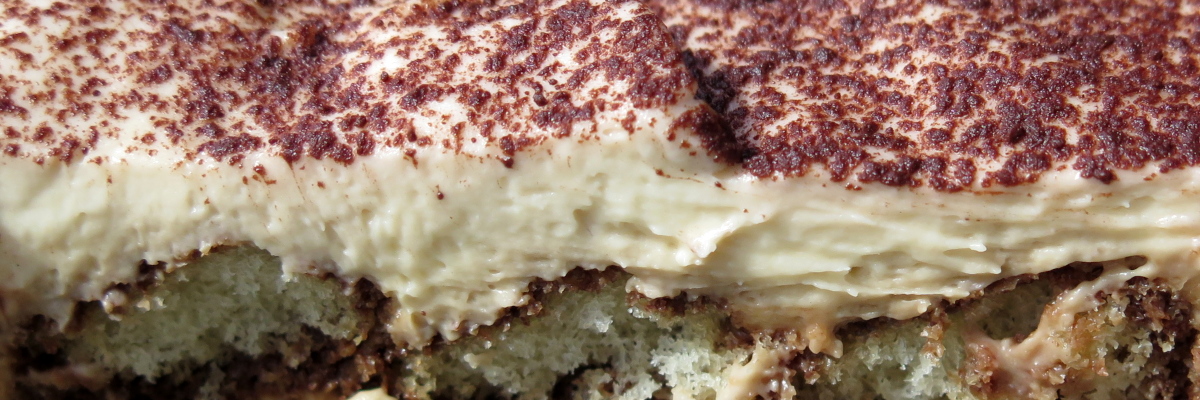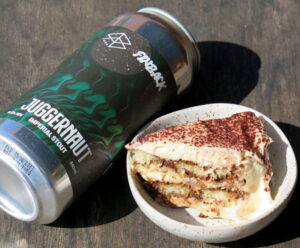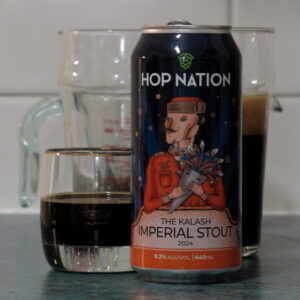
Tiramisu, but with a nice strong stout instead of the liqueur or fortified wine the recipe might call for,1 has become one of those things that I’ll make at the slightest provocation. As a staff treat for a looming busy night, if some newly released beer seems like it might work nicely, or if I find a kilo of mascarpone on special; pretty much any excuse will do. It’s always a hit, so I’m well overdue to share what I’ve learned more widely than I can share the thing itself. You deserve a treat — but then we have to have a quick chat about some outdated terminology you’ll probably see when shopping for the right beer to go in it.

Best I can tell from my Diary, a glass of Modern Times’ ‘Black House’ (an excellent coffee stout) made me grab some tiramisu from the (equally excellent) pizza joint near where I used to work, as an act of dead-obvious beer-and-food-matching.2 I’ve forgotten what actually flipped the switch from having it with beer to making it with beer, but within a few weeks I’d already trialled several batches — and had started to ponder posting about it, before realising just how much more difficult food blogging was. Making a beer look good in a weirdly-lit bar isn’t easy, but making a messy dessert in daylight even vaguely appetizing while documenting the steps to get there is something else entirely.3 So rather than reinvent the wheel (or myself), it’s best if I point you to my favourite base recipe, and give a few notes on how I’ve used it.
Stella Parks’ ‘Rich and Creamy Tiramisu’ on Serious Eats is where it’s at for me; a compromise between simpler (easier to make, but less interesting to taste) versions that rely on whipped cream and fussier ones that separate the eggs and recombine them later.4 Her reasoning for her choice of booze actually lends accidental support to using beer instead: she notes that it’s annoying to source high-quality ingredients that don’t have a lot of other uses, especially when the format they’re sold in leaves a lot left over. Of course, a surplus is a handy reason for another batch another day, but (relatively speaking) it’s easy to find a nice strong dark beer at a good price and in a quantity that’ll give you just enough for a little treat as you work.

Beer notes: I’ve used totally straight stouts like my beloved 8 Wired ‘iStout’ (more famous for its use in an ice cream float), and ones with a bunch of flavour adjuncts like the Range-Finback collab ‘Juggernaut’, brewed with cinnamon, vanilla, cacao and honey. I even tried a tiramisu themed beer from Mountain Culture, unable to resist the ridiculous recursion of it all. They’ve all been great, but my best general advice is probably to go for something with a little barrel-aged character; the hints of wood and spirit are nice extras that seem to cut through and get noticed. I also still mix in a little coffee and cocoa, and pour the stout back and forth between a couple of pint glasses before using it, to knock the bubbles out of it (reasoning that the acidity from the CO2 would be unwelcome).
’misu notes: Stella advocates pretty hard for making your own savoiardi, and I’m sure it’s rewarding but for me that’s too much faff and would mean I made the whole thing less often. Store bought ones are fine, they’re just annoying to find (not quite a biscuit, not quite an ingredient) and asking where the “lady fingers” are will get you weird looks sometimes. The step where you heat the eggs is the trickiest; it took me several tries to get a system that worked and didn’t feel like I was going to scald myself with the steam but it’s extremely gear-dependent so I can’t offer much useful advice other than the trick of stirring with your thermometer itself because the timing between raw egg and proto-omelette feels very fine indeed. Apparently it helps the eggs whip up, but you can lowball the temperature a little5 and if you do get a faint whiff of scrambled egg (or even a few streaks of cooked bits in the mix), fear not; it will dissipate. As for assembly, I skip the between-layers cocoa and go very light on the dusting on top, keen to avoid the dry-powder-induced coughing fit. Two or three layers is fine; just one is disappointing, higher is unwieldy. I parcel a batch into whatever containers are free — it’s extremely forgiving and shapeable, and then I’ve got some for my comrades at work, some to give to a friend, plenty for myself. And definitely give it overnight in the fridge to meld together.
Right. Now that the treats are taken care of, it’s time for some medicine: it is gross and outdated to use the word “Imperial” to mean “strong”. We need to stop.

My most-recent beeramisu was made with Hop Nation’s ‘Kalash’,6 a barrel aged strong stout they’ve released in various forms annually since 2016. It was originally branded a ‘Russian Imperial Stout’, but that first word was dropped (and the character on the label was disarmed) after Putin’s invasion of Ukraine in early 2022.7 At the time, there was a flurry of fundraising new releases and some recontextualising of existing beers like Hop Nation did here — I remember Garage Project even adding sunflower stickers to (and donating the proceeds of) their only-tangentially “Russian” Baltic Porter. But if you can see why it’s inappropriate to glorify Russia right now, it ought to be obvious why “Imperial” shouldn’t ever be a reference with any honour. No one builds an Empire and keeps their hands clean; they are defined by conquest and inequality. Here in Australia and New Zealand, it’s not hard to find beers with the awkward juxtaposition of a moderately progressive gesture like recognising a traditional placename or featuring a native ingredient — and that word in big text on the front label, casually evoking the devastating colonial power as if it was a neutral way to signify strength.8
My general sense is that use of “Imperial” has faded away a lot for IPA. Not completely, granted; it showed up just the other day as a clue in the New York Times crossword,9 partially inspiring me to make this very note. And — as David Jesudason noted in his excellent piece on Good Beer Hunting (RIP) a few years ago — it’s often still sold in ways that clumsily glorify Empire. But maybe the more common IPA strength indicators give us a better model to follow for stout: ‘Double Stout’ (and indeed ‘Triple Stout’, if you like) already sees a fair bit of use by several breweries, and seems perfectly comprehensible to most consumers.10 It’s an easy fix. Certainly easier than waiting overnight before having some of the beeramisu you just made. But also worth it.
- Given the language of origin, it should probably be called birramisu, but the easiest to find recipes under that spelling both involved pale ale among other questionable choices, so I’m going with the linguistic-hybrid naming here. Which seems apt, anyhow.
- Which is a longstanding thing I like to do; Chimay Red and the cheese made with Chimay beer, that kind of thing. Or something sillier, like Double Brown and a KFC Double Down.
- Dan Olson’s video ‘Cooking On The Internet for Fun and Profit’ is well worth your time.
- Though it does require an electric mixer. If you don’t have one of those, beating the eggs separately is admittedly way easier.
- If you have a particular need to avoid raw eggs, I can’t imagine that heating them Stella’s way would feel safe enough, so this is more about getting the air into them at the next step than it is about pasteurising them. For folks without specific dietary concerns, this recipe (which I think might be the first one I ever followed) makes the case that they’re generally low risk raw.
- It’s not great that it’s named after a gun, but I’m going to leave that aside for now and focus on the more-widely-applicable style terms.
- The brewer’s notes in the release announcement — casting it as an “aggressive Ruski” that “takes no prisoners and asks no surrender” — are extremely yikes in hindsight.
- Sadly, it’s also still possible to find examples of breweries tripping at a much earlier hurdle and making an ass of themselves more obviously.
- 50 down, 2 July 2024: “Imperial ___ (beer order)”. A pretty crappy clue for IPA, if you ask me, but it does show — by my own metric for these things — that this usage is still current and widely known, or at least Not Dead Yet.
- And has at least as deep a usage history as “Imperial”, if you care about such things. If matching the strength brackets for modern IPA would mean shifting the historical sense of them for “double stout” and “double porter”, I can’t see the harm.
